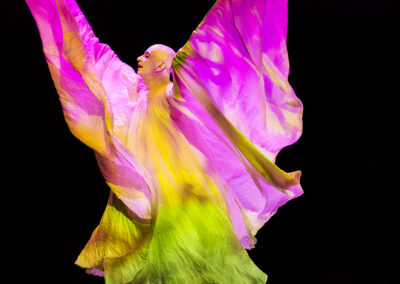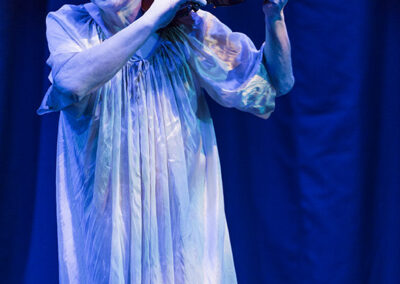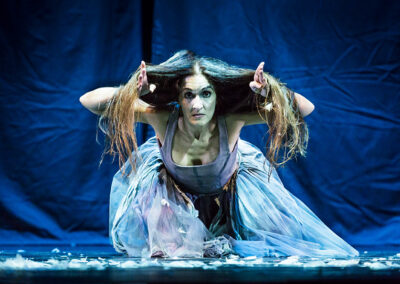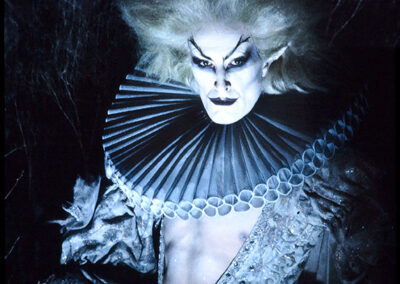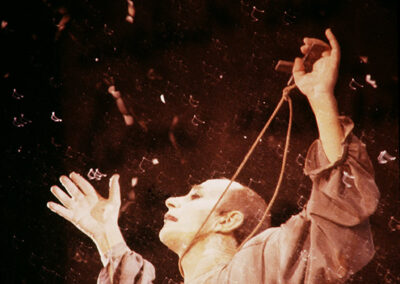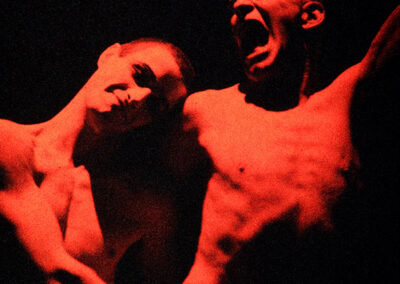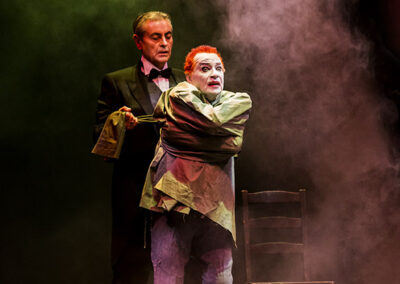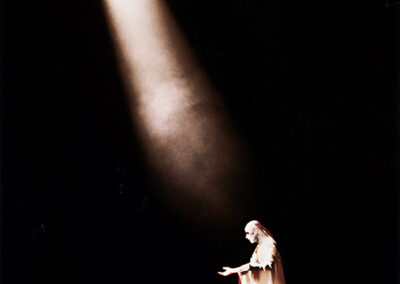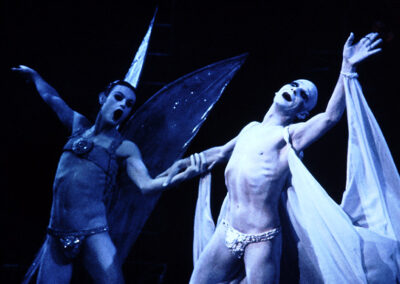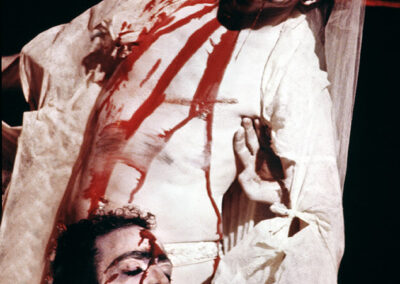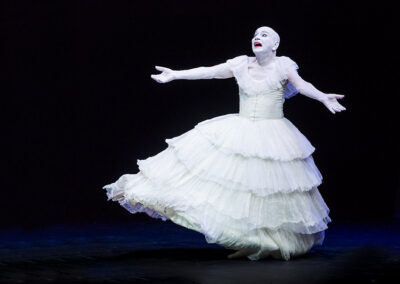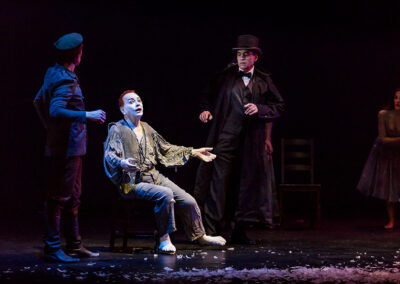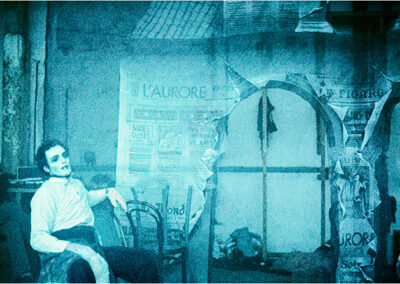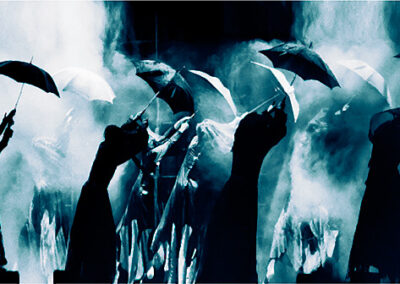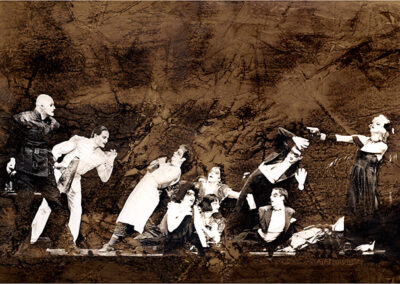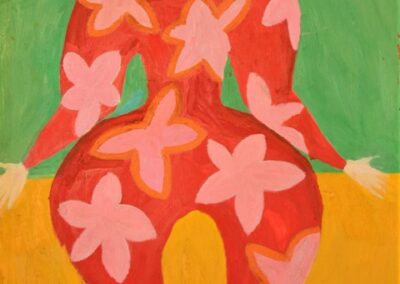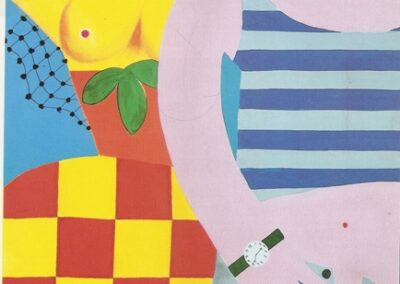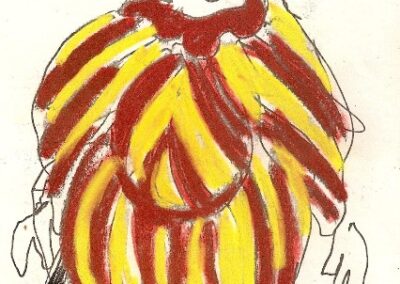Our next Artist You Need To Know is Lindsay Kemp. Kemp (1938 – 2018) was a British dancer, actor, teacher, mime artist, and choreographer. Perhaps best known for his production of Flowers (1974), which was a mime and music show based upon Jean Genet’s novel Our Lady of the Flowers, in which he portrayed Divine, the lead role. Despite the “homosexual themes and perceived decadence” which spurred some festering reviews “it was widely considered a theatrical and sensory sensation, and it toured globally for many years.” Kemp occupied numerous artistic spaces, both in more classical spheres of dance and performance, but is also familiar to many for his work mentoring the music stars David Bowie and Kate Bush. (from here)
The latter, in a tribute to Kemp upon his passing, offered the following: “The world has lost a truly original and great artist of the stage. To call him a mime artist is like calling Mozart a pianist. He was very brave, very funny and above all, astonishingly inspirational.”
From his obituary in The Guardian: ‘There was undoubtedly an element of self-conscious martyrdom and masochism in the way he offered himself to an audience, a riff on the myth of Saint Sebastian (he appeared in Derek Jarman’s 1976 film, Sebastiane, about that gay icon), but there was beauty and elegance, too, a boneless majesty and Japanese kabuki-style intensity in his movement, with the almost comic caveat of what one critic described as “unexpectedly broad hands and spatulate fingers”’.
Born in Birkenhead, growing up in South Shields near Newcastle upon Tyne in the U.K., Kemp’s father was lost at sea in 1940. Kemp was a performer from his early childhood: “I’d dance on the kitchen table to entertain the neighbours. I mean, it was a novelty in South Shields to see a little boy in full make-up dancing on pointe. Finally it got a bit too much for my mother, and she decided to send me to boarding school at the age of eight, hoping that it would knock some sense into me.” Later, Kemp and his mother moved to Bradford, Yorkshire, where Kemp attended Bradford Art College before studying dance with Hilde Holger and mime with Marcel Marceau. Like many of his generation, Kemp served in the RAF in the 1950s: years later, speaking with the BBC, he joked that he was often reprimanded for being “unable to march properly due to his desire to dance.”
Photographer Richard Haughton has “the largest and most complete existing collection of photos of Lindsay Kemp and his work. As a close friend and occasional performer with the Lindsay Kemp Company, he was Lindsay’s favoured photographer from 1974 to 2018, becoming an international specialist in theatre, dance and music photography.” A wonderful page – as part of the larger site dedicated to Kemp’s life and work that can be enjoyed here – is Glimpses of a Lindsay Kemp World, 1974-2018, which features many images of Kemp and his productions. We offer a sampling, in the respective galleries accompanying this article: all photos included here are the fine work of Haughton, who captures the vivacity of Kemp’s performances and productions, and yet also has images that are still and serene, of the quieter moments of Kemp’s work.
Kemp’s career was impressive, and this is just a taste of his many accomplishments. (An excellent resource for more about his accomplishments would be to visit this site).
In 1963, Kemp had the role of the Player Queen in the BBC’s Shakespeare Quatercentenary production Hamlet at Elsinore (recorded on site at Elsinore castle) in 1963 (this production included Christopher Plummer). Forming his own company in the early sixties, Kemp performed at the Edinburgh Festival in 1968 – the previously mentioned work Flowers : “its extraordinary dream-like opening scene of prisoners masturbating in their cells, while the silhouette of a beautiful male angel walked slowly across the stage, his wings reaching almost to the top of the proscenium, established the tone.” (from here)
Other significant performances include “Pierrot In Turquoise, Salome, Mr Punch’s Pantomime, A Midsummer Night’s Dream, Duende, Nijinsky, Alice, Cenerentola (Cinderella), Nijinsky il matto (1983) (translation: Nijinsky the fool) Façade, The Big Parade, Onnagata, Variété, Dream Dances, and, for Ballet Rambert, Parades Gone By (1975) and Cruel Garden (1977)…[and] most of these works in collaboration with composer Carlos Miranda. Variété was later produced by Youth Music Theatre UK at the Riverside Studios in 2013 directed by Kinny Gardner.” (from here)
But Kemp’s legacy is as much as a teacher as a performer in the fields of dance and mime. Famous students in the 1970s include David Bowie, Kate Bush, and Vivian Stanshall. This served as a way for Kemp’s aesthetic to move from the stage and theatre into the realms of music and contemporary popular culture. David Bowie’s ZIggy Stardust concerts, mounted at London’s Rainbow Theatre in 1972, was a collaboration between Kemp, Jack Birkett and Bowie. Kemp also performed in Bowie’s video for the song John, I’m Only Dancing and Kate Bush collaborated with Kemp, providing vocals to a number of performative pieces.
From this Kemp also stepped into films: some significant roles “include a supporting role in the Kate Bush short film The Line, the Cross & the Curve (1994), a dancer and cabaret performer in Derek Jarman’s Sebastiane (1976) and Jubilee (1977) respectively, a pantomime dame in Todd Haynes’ Velvet Goldmine (1998) and the pub landlord Alder MacGregor in Anthony Shaffer’s The Wicker Man (1973).” (from here)
On top of all that, Kemp sometimes produced operatic works, usually in Italy. These include Il Barbiere di Siviglia (1995), Iris (1998), and Die Zauberflöte (1999). Kemp “returned to Livorno in November 2016 with a new production Die Zauberflöte in which he also designed the sets and costumes, as well as co-lighting the production. In the seasons from 2005 to 2012 he plays the role of the fairy Carabosse in The Sleeping Beauty of the Italian company Balletto del Sud with the Fredy Franzutti’s choreography. The collaboration with the company and with Franzutti also continues with the interpretation of the magician Kašej in The Firebird in the seasons from 2007 to 2010, the shows have been repeated in several Italian tours.” (from here)
Kemp’s final public performance in his native England in 2018 was – again – about straddling the boundaries of dance, theatre, music and popular culture: this was a collaboration with singer songwriter Tim Arnold at Manchester’s Bridgewater Hall in a multimedia live arts installation of Arnold’s song What Love Would Want.
At the age of 80, while in Livorno, Italy, Kemp passed. Richard Haughton (who besides being a fine photographer, whose work we strongly suggest you check out online as well, at his site) was Kemp’s closest friend and collaborator for nearly half a century said later that Kemp was vibrant and active nearly up to the moment of his death and that “he suddenly said he felt ill, and a minute and a half later he was gone.”



